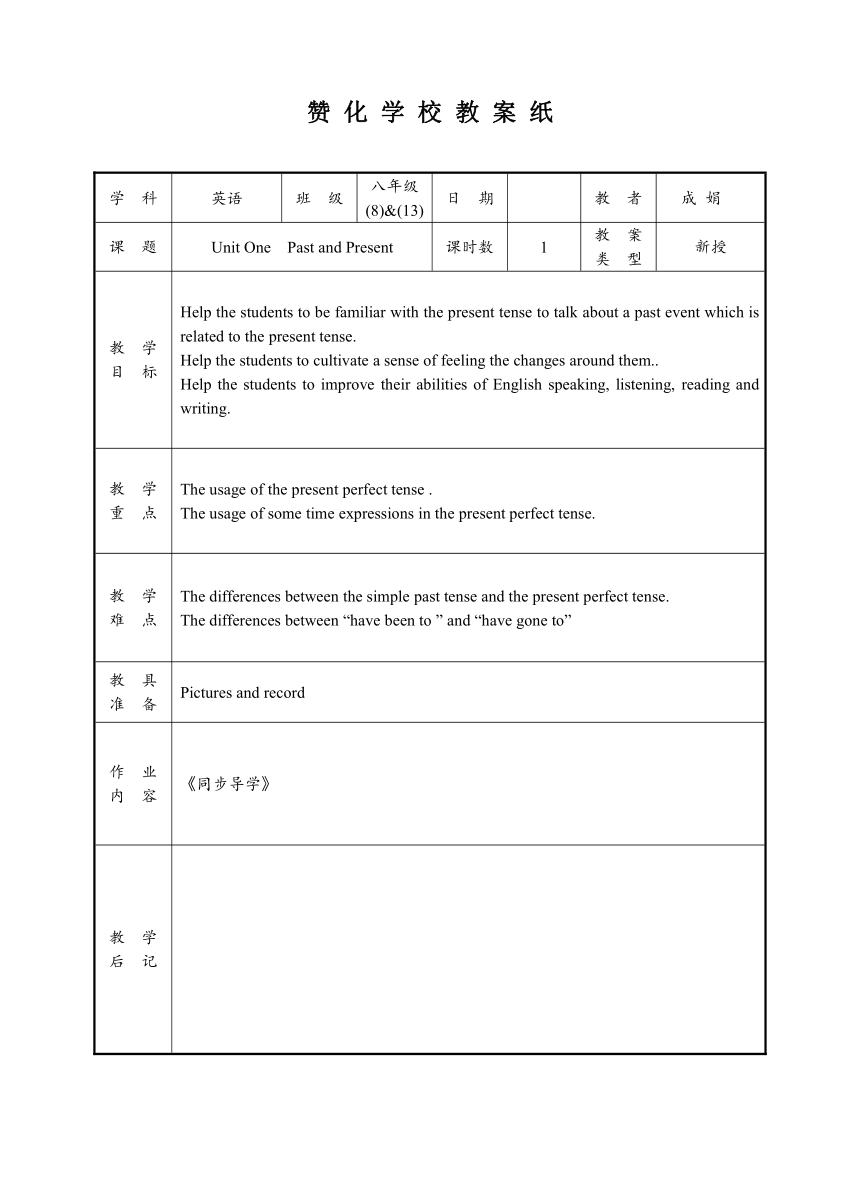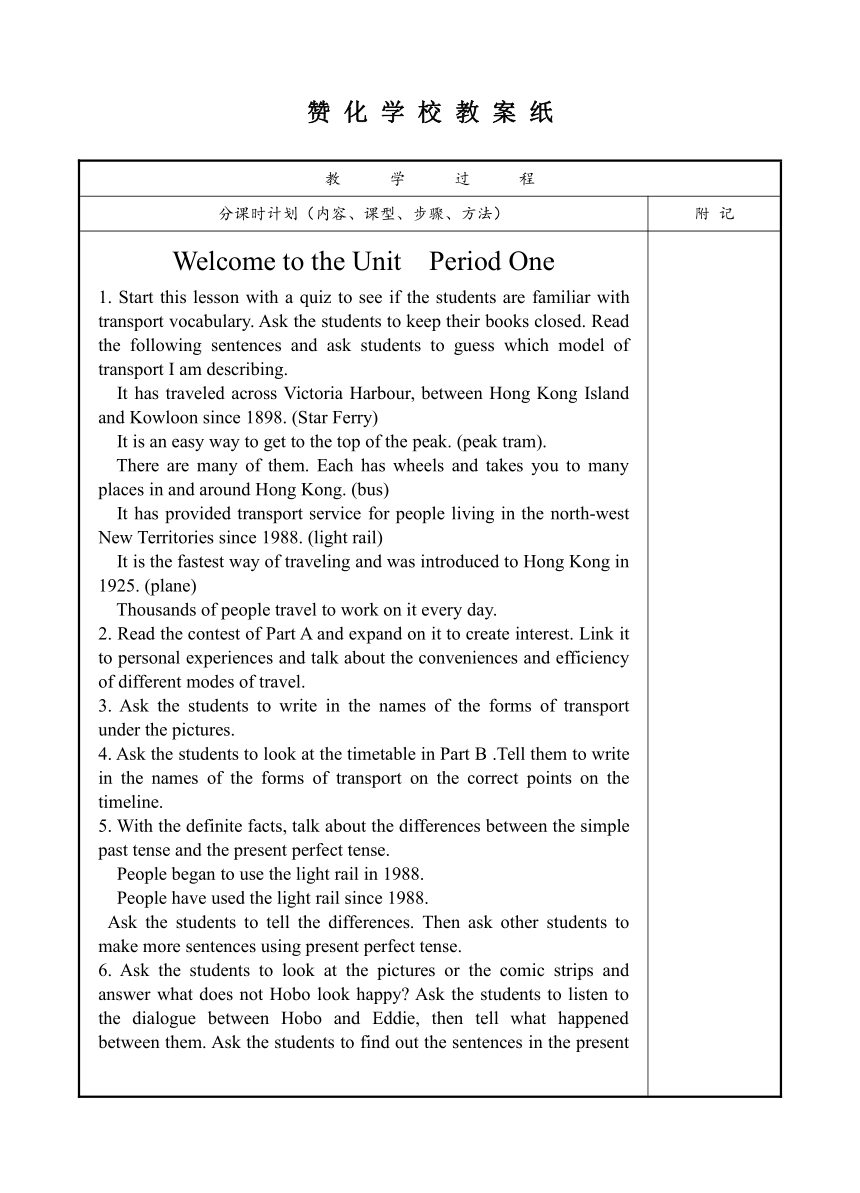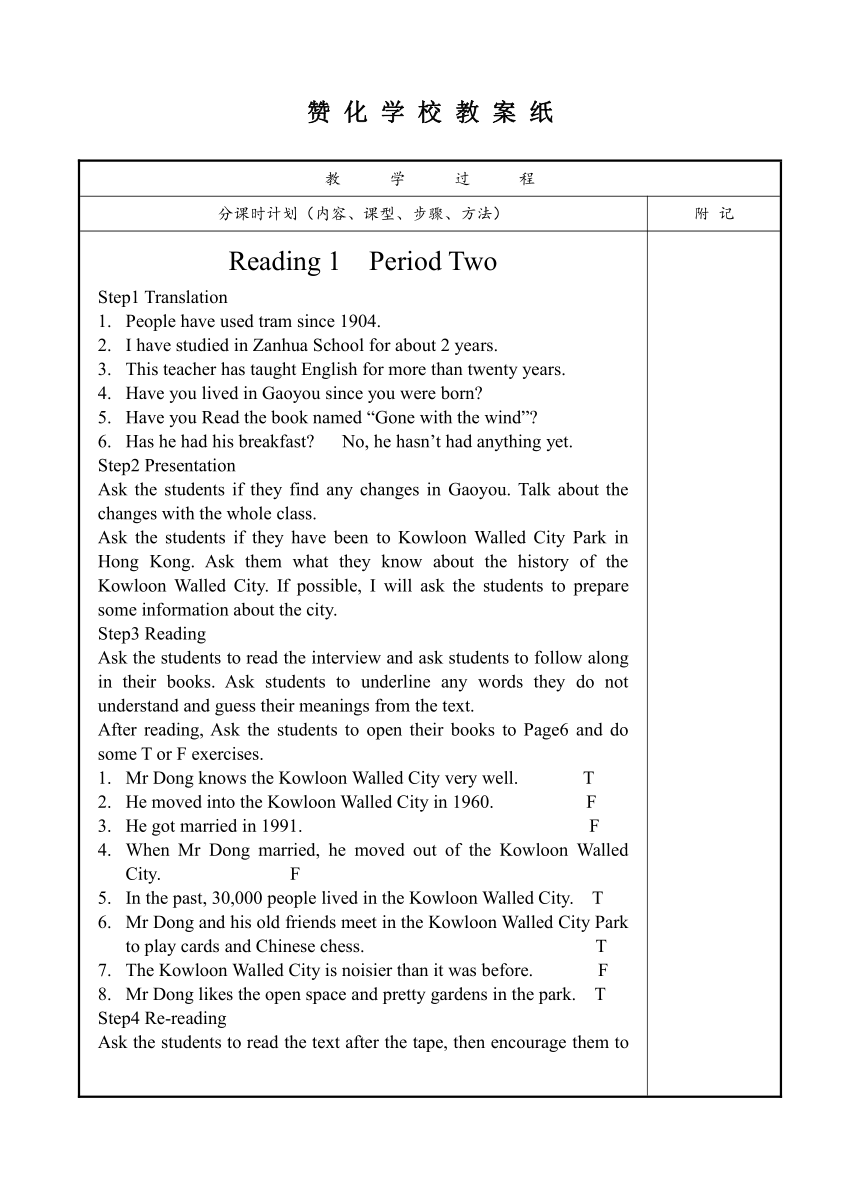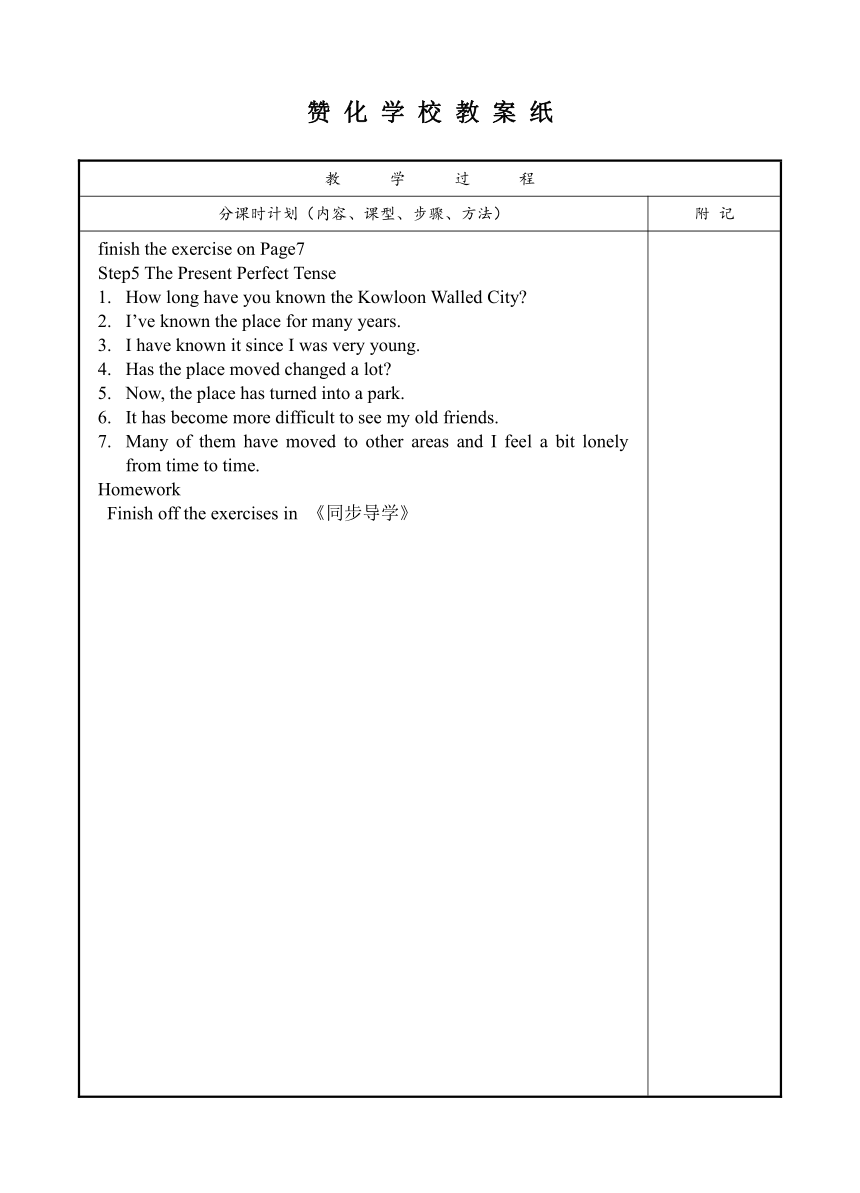牛津英语8B Unit1 Past and present 教案(Period One-Period Four)[下学期]
文档属性
| 名称 | 牛津英语8B Unit1 Past and present 教案(Period One-Period Four)[下学期] |  | |
| 格式 | rar | ||
| 文件大小 | 16.2KB | ||
| 资源类型 | 教案 | ||
| 版本资源 | 牛津译林版 | ||
| 科目 | 英语 | ||
| 更新时间 | 2009-03-17 09:34:00 | ||
图片预览





文档简介
赞 化 学 校 教 案 纸
学 科 英语 班 级 八年级(8)&(13) 日 期 教 者 成 娟
课 题 Unit One Past and Present 课时数 1 教 案类 型 新授
教 学目 标 Help the students to be familiar with the present tense to talk about a past event which is related to the present tense.Help the students to cultivate a sense of feeling the changes around them..Help the students to improve their abilities of English speaking, listening, reading and writing.
教 学重 点 The usage of the present perfect tense .The usage of some time expressions in the present perfect tense.
教 学难 点 The differences between the simple past tense and the present perfect tense.The differences between “have been to ” and “have gone to”
教 具准 备 Pictures and record
作 业内 容 《同步导学》
教 学后 记
赞 化 学 校 教 案 纸
教 学 过 程
分课时计划(内容、课型、步骤、方法) 附 记
赞 化 学 校 教 案 纸
教 学 过 程
分课时计划(内容、课型、步骤、方法) 附 记
赞 化 学 校 教 案 纸
教 学 过 程
分课时计划(内容、课型、步骤、方法) 附 记
赞 化 学 校 教 案 纸
教 学 过 程
分课时计划(内容、课型、步骤、方法) 附 记
赞 化 学 校 教 案 纸
教 学 过 程
分课时计划(内容、课型、步骤、方法) 附 记
赞 化 学 校 教 案 纸
教 学 过 程
分课时计划(内容、课型、步骤、方法) 附 记
赞 化 学 校 教 案 纸
教 学 过 程
分课时计划(内容、课型、步骤、方法) 附 记
赞 化 学 校 教 案 纸
教 学 过 程
分课时计划(内容、课型、步骤、方法) 附 记
赞 化 学 校 教 案 纸
教 学 过 程
分课时计划(内容、课型、步骤、方法) 附 记
赞 化 学 校 教 案 纸
教 学 过 程
分课时计划(内容、课型、步骤、方法) 附 记
赞 化 学 校 教 案 纸
教 学 过 程
分课时计划(内容、课型、步骤、方法) 附 记
Welcome to the Unit Period One
1. Start this lesson with a quiz to see if the students are familiar with transport vocabulary. Ask the students to keep their books closed. Read the following sentences and ask students to guess which model of transport I am describing.
It has traveled across Victoria Harbour, between Hong Kong Island and Kowloon since 1898. (Star Ferry)
It is an easy way to get to the top of the peak. (peak tram).
There are many of them. Each has wheels and takes you to many places in and around Hong Kong. (bus)
It has provided transport service for people living in the north-west New Territories since 1988. (light rail)
It is the fastest way of traveling and was introduced to Hong Kong in 1925. (plane)
Thousands of people travel to work on it every day.
2. Read the contest of Part A and expand on it to create interest. Link it to personal experiences and talk about the conveniences and efficiency of different modes of travel.
3. Ask the students to write in the names of the forms of transport under the pictures.
4. Ask the students to look at the timetable in Part B .Tell them to write in the names of the forms of transport on the correct points on the timeline.
5. With the definite facts, talk about the differences between the simple past tense and the present perfect tense.
People began to use the light rail in 1988.
People have used the light rail since 1988.
Ask the students to tell the differences. Then ask other students to make more sentences using present perfect tense.
6. Ask the students to look at the pictures or the comic strips and answer what does not Hobo look happy Ask the students to listen to the dialogue between Hobo and Eddie, then tell what happened between them. Ask the students to find out the sentences in the present perfect tense. Find out if they have mastered it well. Let the students to practice the dialogue and then try to act it out.
7. Homework
Finish the exercises in 《同步导学》
Reading 1 Period Two
Step1 Translation
1. People have used tram since 1904.
2. I have studied in Zanhua School for about 2 years.
3. This teacher has taught English for more than twenty years.
4. Have you lived in Gaoyou since you were born
5. Have you Read the book named “Gone with the wind”
6. Has he had his breakfast No, he hasn’t had anything yet.
Step2 Presentation
Ask the students if they find any changes in Gaoyou. Talk about the changes with the whole class.
Ask the students if they have been to Kowloon Walled City Park in Hong Kong. Ask them what they know about the history of the Kowloon Walled City. If possible, I will ask the students to prepare some information about the city.
Step3 Reading
Ask the students to read the interview and ask students to follow along in their books. Ask students to underline any words they do not understand and guess their meanings from the text.
After reading, Ask the students to open their books to Page6 and do some T or F exercises.
1. Mr Dong knows the Kowloon Walled City very well. T
2. He moved into the Kowloon Walled City in 1960. F
3. He got married in 1991. F
4. When Mr Dong married, he moved out of the Kowloon Walled City. F
5. In the past, 30,000 people lived in the Kowloon Walled City. T
6. Mr Dong and his old friends meet in the Kowloon Walled City Park to play cards and Chinese chess. T
7. The Kowloon Walled City is noisier than it was before. F
8. Mr Dong likes the open space and pretty gardens in the park. T
Step4 Re-reading
Ask the students to read the text after the tape, then encourage them to finish the exercise on Page7
Step5 The Present Perfect Tense
1. How long have you known the Kowloon Walled City
2. I’ve known the place for many years.
3. I have known it since I was very young.
4. Has the place moved changed a lot
5. Now, the place has turned into a park.
6. It has become more difficult to see my old friends.
7. Many of them have moved to other areas and I feel a bit lonely from time to time.
Homework
Finish off the exercises in 《同步导学》
Reading 2 Period 3
1. Lily’ grandfather, Mr Dong, came to Beijing to visit her.
(! ) visit 作及物动词,其后可接人或地点作宾语。
e.g., He visited China last year.
I often visit my friends on Sunday.
(2) make/pay a visit to 为习惯表达,意为“参观,拜访”此时它是名词。
(3) on a visit to 为“访问某人,参观某地或在某人家做客”
2. He used to live in the kowloon Walled City in Hong Kong.
英语中,used to 后既可接行为动词也可接表示状态的动词原形,主要是同现在相比较,说明过去常常如此,而现在不是这样了。
She used to be a history teacher.
My mother used to get up early when she was young.
used to 的否定形式一般用didn’t use to, 其疑问形式用Did sb use to。
He didn’t use to drink beer. = He usedn’t to drink beer.
Did she use to be an English teacher =Used she to be an English teacher
3. In fact, I was born there and have known it since I was young.
in fact 意为“事实上”
e.g., I said it was Tuesday, but in fact it was Monday.
be born 意为出生。
Many babies are born in this hospital.
The baby was born on a cold morning.
4. So, have you actually lived in the Kowloon Walled City
这么说,你居然在九龙城寨住过?
Actually是副词,意为“实际上,竟然,居然”等。
Did you actually see the traffic accident
5. We lived to together until 1960 when I got married.
They walked until it got dark.
We talked happily until Mr Wu told us to be quiet.
married此处是形容词,意为“结了婚的”,常在系动词be和get 后作表语。构成be married to 意为与某人结婚,常用来表示婚姻的状态。
e.g., She got married to a handsome man.
6. Now, the place has turned into a park.
(!) 句中的turn 是动词,意为“变成,改变”,与become 意思相近。
e.g., At a low temperature, water turns to ice.
He was a teacher when he was young, but he turned into a writer when he got older.
(2) turn into意为“变成了”或“把某物变成了”
e.g., She turned her house into a shop.
Her daughter has turned into a college student.
6. Many of them have moved to other areas and I feel a bit lonely from time to time.
a bit意为“有点,稍微”多用于口语。
I’m a bit tired today.
Could you turn the radio down a bit
A bit of 需加名词。如:I learned a bit of French at school.
a bit ,a little的意义及用法基本相同,但在否定句中他们的意义不同。
e.g., I’m not a bit tired now. = I’m not tired at all now.
I’m not a little tired now. =I’m very tired.
From time to time 表示“有时候,时常”
From time to time, the thief stopped and looked around.
7. After the interview with Mr Dong, Millie wants to find out the meanings of the words she doesn’t know.
find out 表示经过周折或努力“找出,查清楚,或查明某事”
e.g., Do you think the police will find them out
At last, he found out the trurh.
Homework
Finish the exercises in《同步导学》
Vocabulary Period 4
Step 1 Revision
live together get married
in the same block move to another flat
move out of change a lot
in the past turn into
go back play Chinese chess
the closing of the old airport miss the plane
land safely have open space
many of them feel a little lonely
from time to time take off
1.How long have you known the Kowloon Walled City
2.I’ve known the place for many years.
3.I have known it since I was very young.
4.Has the place changed a lot
5.Now, the place has turned into a park.
6.It has become more difficult to see my old friends.
7.Many of them have moved to other areas and I feel a bit lonely from time to time.
Step 2 Revisio
Review the concept of opposites. Ask students to give some examples and write them on the board, e.g.
first last
love hate
noisy quiet
day night
rich poor
usual unusual
big small
Step 3 Opposites
Ask the students to read the list of words on Page8 and check understanding. Provide definitions or description of the less familiar words.
Step 4 Reading
Tell students to read Millie’ e-file. Explain that some of the words have to be changed to their opposites so that the right meaning is conveyed.
Ask the students to underline the incorrect words and write the correct words above the mistakes. Tell them that all the words they need can be found on the list above the file.
Check the answers with the whole class.
Step 5 Homework
Finish off the exercises in《同步导学》
学 科 英语 班 级 八年级(8)&(13) 日 期 教 者 成 娟
课 题 Unit One Past and Present 课时数 1 教 案类 型 新授
教 学目 标 Help the students to be familiar with the present tense to talk about a past event which is related to the present tense.Help the students to cultivate a sense of feeling the changes around them..Help the students to improve their abilities of English speaking, listening, reading and writing.
教 学重 点 The usage of the present perfect tense .The usage of some time expressions in the present perfect tense.
教 学难 点 The differences between the simple past tense and the present perfect tense.The differences between “have been to ” and “have gone to”
教 具准 备 Pictures and record
作 业内 容 《同步导学》
教 学后 记
赞 化 学 校 教 案 纸
教 学 过 程
分课时计划(内容、课型、步骤、方法) 附 记
赞 化 学 校 教 案 纸
教 学 过 程
分课时计划(内容、课型、步骤、方法) 附 记
赞 化 学 校 教 案 纸
教 学 过 程
分课时计划(内容、课型、步骤、方法) 附 记
赞 化 学 校 教 案 纸
教 学 过 程
分课时计划(内容、课型、步骤、方法) 附 记
赞 化 学 校 教 案 纸
教 学 过 程
分课时计划(内容、课型、步骤、方法) 附 记
赞 化 学 校 教 案 纸
教 学 过 程
分课时计划(内容、课型、步骤、方法) 附 记
赞 化 学 校 教 案 纸
教 学 过 程
分课时计划(内容、课型、步骤、方法) 附 记
赞 化 学 校 教 案 纸
教 学 过 程
分课时计划(内容、课型、步骤、方法) 附 记
赞 化 学 校 教 案 纸
教 学 过 程
分课时计划(内容、课型、步骤、方法) 附 记
赞 化 学 校 教 案 纸
教 学 过 程
分课时计划(内容、课型、步骤、方法) 附 记
赞 化 学 校 教 案 纸
教 学 过 程
分课时计划(内容、课型、步骤、方法) 附 记
Welcome to the Unit Period One
1. Start this lesson with a quiz to see if the students are familiar with transport vocabulary. Ask the students to keep their books closed. Read the following sentences and ask students to guess which model of transport I am describing.
It has traveled across Victoria Harbour, between Hong Kong Island and Kowloon since 1898. (Star Ferry)
It is an easy way to get to the top of the peak. (peak tram).
There are many of them. Each has wheels and takes you to many places in and around Hong Kong. (bus)
It has provided transport service for people living in the north-west New Territories since 1988. (light rail)
It is the fastest way of traveling and was introduced to Hong Kong in 1925. (plane)
Thousands of people travel to work on it every day.
2. Read the contest of Part A and expand on it to create interest. Link it to personal experiences and talk about the conveniences and efficiency of different modes of travel.
3. Ask the students to write in the names of the forms of transport under the pictures.
4. Ask the students to look at the timetable in Part B .Tell them to write in the names of the forms of transport on the correct points on the timeline.
5. With the definite facts, talk about the differences between the simple past tense and the present perfect tense.
People began to use the light rail in 1988.
People have used the light rail since 1988.
Ask the students to tell the differences. Then ask other students to make more sentences using present perfect tense.
6. Ask the students to look at the pictures or the comic strips and answer what does not Hobo look happy Ask the students to listen to the dialogue between Hobo and Eddie, then tell what happened between them. Ask the students to find out the sentences in the present perfect tense. Find out if they have mastered it well. Let the students to practice the dialogue and then try to act it out.
7. Homework
Finish the exercises in 《同步导学》
Reading 1 Period Two
Step1 Translation
1. People have used tram since 1904.
2. I have studied in Zanhua School for about 2 years.
3. This teacher has taught English for more than twenty years.
4. Have you lived in Gaoyou since you were born
5. Have you Read the book named “Gone with the wind”
6. Has he had his breakfast No, he hasn’t had anything yet.
Step2 Presentation
Ask the students if they find any changes in Gaoyou. Talk about the changes with the whole class.
Ask the students if they have been to Kowloon Walled City Park in Hong Kong. Ask them what they know about the history of the Kowloon Walled City. If possible, I will ask the students to prepare some information about the city.
Step3 Reading
Ask the students to read the interview and ask students to follow along in their books. Ask students to underline any words they do not understand and guess their meanings from the text.
After reading, Ask the students to open their books to Page6 and do some T or F exercises.
1. Mr Dong knows the Kowloon Walled City very well. T
2. He moved into the Kowloon Walled City in 1960. F
3. He got married in 1991. F
4. When Mr Dong married, he moved out of the Kowloon Walled City. F
5. In the past, 30,000 people lived in the Kowloon Walled City. T
6. Mr Dong and his old friends meet in the Kowloon Walled City Park to play cards and Chinese chess. T
7. The Kowloon Walled City is noisier than it was before. F
8. Mr Dong likes the open space and pretty gardens in the park. T
Step4 Re-reading
Ask the students to read the text after the tape, then encourage them to finish the exercise on Page7
Step5 The Present Perfect Tense
1. How long have you known the Kowloon Walled City
2. I’ve known the place for many years.
3. I have known it since I was very young.
4. Has the place moved changed a lot
5. Now, the place has turned into a park.
6. It has become more difficult to see my old friends.
7. Many of them have moved to other areas and I feel a bit lonely from time to time.
Homework
Finish off the exercises in 《同步导学》
Reading 2 Period 3
1. Lily’ grandfather, Mr Dong, came to Beijing to visit her.
(! ) visit 作及物动词,其后可接人或地点作宾语。
e.g., He visited China last year.
I often visit my friends on Sunday.
(2) make/pay a visit to 为习惯表达,意为“参观,拜访”此时它是名词。
(3) on a visit to 为“访问某人,参观某地或在某人家做客”
2. He used to live in the kowloon Walled City in Hong Kong.
英语中,used to 后既可接行为动词也可接表示状态的动词原形,主要是同现在相比较,说明过去常常如此,而现在不是这样了。
She used to be a history teacher.
My mother used to get up early when she was young.
used to 的否定形式一般用didn’t use to, 其疑问形式用Did sb use to。
He didn’t use to drink beer. = He usedn’t to drink beer.
Did she use to be an English teacher =Used she to be an English teacher
3. In fact, I was born there and have known it since I was young.
in fact 意为“事实上”
e.g., I said it was Tuesday, but in fact it was Monday.
be born 意为出生。
Many babies are born in this hospital.
The baby was born on a cold morning.
4. So, have you actually lived in the Kowloon Walled City
这么说,你居然在九龙城寨住过?
Actually是副词,意为“实际上,竟然,居然”等。
Did you actually see the traffic accident
5. We lived to together until 1960 when I got married.
They walked until it got dark.
We talked happily until Mr Wu told us to be quiet.
married此处是形容词,意为“结了婚的”,常在系动词be和get 后作表语。构成be married to 意为与某人结婚,常用来表示婚姻的状态。
e.g., She got married to a handsome man.
6. Now, the place has turned into a park.
(!) 句中的turn 是动词,意为“变成,改变”,与become 意思相近。
e.g., At a low temperature, water turns to ice.
He was a teacher when he was young, but he turned into a writer when he got older.
(2) turn into意为“变成了”或“把某物变成了”
e.g., She turned her house into a shop.
Her daughter has turned into a college student.
6. Many of them have moved to other areas and I feel a bit lonely from time to time.
a bit意为“有点,稍微”多用于口语。
I’m a bit tired today.
Could you turn the radio down a bit
A bit of 需加名词。如:I learned a bit of French at school.
a bit ,a little的意义及用法基本相同,但在否定句中他们的意义不同。
e.g., I’m not a bit tired now. = I’m not tired at all now.
I’m not a little tired now. =I’m very tired.
From time to time 表示“有时候,时常”
From time to time, the thief stopped and looked around.
7. After the interview with Mr Dong, Millie wants to find out the meanings of the words she doesn’t know.
find out 表示经过周折或努力“找出,查清楚,或查明某事”
e.g., Do you think the police will find them out
At last, he found out the trurh.
Homework
Finish the exercises in《同步导学》
Vocabulary Period 4
Step 1 Revision
live together get married
in the same block move to another flat
move out of change a lot
in the past turn into
go back play Chinese chess
the closing of the old airport miss the plane
land safely have open space
many of them feel a little lonely
from time to time take off
1.How long have you known the Kowloon Walled City
2.I’ve known the place for many years.
3.I have known it since I was very young.
4.Has the place changed a lot
5.Now, the place has turned into a park.
6.It has become more difficult to see my old friends.
7.Many of them have moved to other areas and I feel a bit lonely from time to time.
Step 2 Revisio
Review the concept of opposites. Ask students to give some examples and write them on the board, e.g.
first last
love hate
noisy quiet
day night
rich poor
usual unusual
big small
Step 3 Opposites
Ask the students to read the list of words on Page8 and check understanding. Provide definitions or description of the less familiar words.
Step 4 Reading
Tell students to read Millie’ e-file. Explain that some of the words have to be changed to their opposites so that the right meaning is conveyed.
Ask the students to underline the incorrect words and write the correct words above the mistakes. Tell them that all the words they need can be found on the list above the file.
Check the answers with the whole class.
Step 5 Homework
Finish off the exercises in《同步导学》
